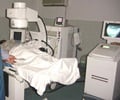Fluorescing urine indicates organ transplant rejection. Nanoparticle sensors emit fluorescent signals that pass out in the urine, which exhibits fluorescence. This test will enable early detection of rejection.
- Fluorescing urine can be indicative of organ transplant rejection
- This is mediated by nanoparticle sensors that emit signals, which pass in the urine and make it fluorescent
- This urine test will enable early detection of transplant rejection so that timely treatment can be instituted
Scientists at the Georgia Tech School of Engineering and Emory University, USA have developed these novel nanoparticle-based sensors using biocompatible materials. This means that it will be easier for the new technology to be approved for human clinical trials in the future, without facing any ethical issues.
The study, published in the journal Nature Biomedical Engineering, was jointly led by Dr. Gabe A. Kwong, PhD and Dr. Andrew B. Adams, MD, PhD.
Dr. Kwong is an Assistant Professor in the Wallace H. Coulter Department of Biomedical Engineering at Georgia Tech School of Engineering and Emory University School of Medicine, USA.
Dr. Adams is an Associate Professor of Surgery in the Division of Transplantation, Department of Surgery at Emory University School of Medicine, USA.
Read More..
Drawbacks of Biopsy - The Gold Standard for Detecting Organ Rejection
Biopsy, in spite of being the Gold Standard for detection, still has certain drawbacks, which include the following:- Tissue Damage: Biopsy can cause tissue damage due to the long, wide needle used for the procedure
- Bleeding: Biopsy can cause bleeding and hemorrhage in and around the transplanted organ
- Misdiagnosis: This can occur since only a small, localized tissue sample can be obtained by biopsy, which does not give the overall picture of what is occurring in the whole organ
- Less Informative: Biopsy is not predictive and provides a static picture of events, which cannot establish whether rejection is progressing or regressing
- Infections: There is a chance of infections during the procedure, particularly if the needle is not sterile
Advantages of the New Technology
- Highly Informative: The test measures the biological activity rates and gives a more global picture of the organ as a whole
- Highly Sensitive: The sensors are capable of emitting a very strong signal when rejection occurs, as the organ as a whole has a large tissue mass
- Early Detection: The test helps in early detection of rejection, since the T-cells release granzyme B well before tissue damage occurs
- Accurate Dosing: The test can help in deciding the correct dosage of immunosuppressants that need to be administered in transplant patients
Structure of the Nanoparticle Sensors
The nanoparticles are assembled by using iron oxide as its spherical core. This is covered by two layers, made up of dextran (glucose polymers) and polyethylene glycol (PEG), which is a component of laxatives. This ensures that the nanoparticles are not excreted out of the body too fast. On the surface of the spherical nanoparticles, are attached amino acid chains that look much like “bristles”. Fluorescent markers consisting of “reporter” molecules are attached to the tips of these bristles. These molecules emit fluorescent signals as soon as organ transplant rejection starts to occur, making the test highly sensitive.Mechanism of Action of the Nanoparticle Sensors
As soon as rejection sets-in, the granzyme B enzyme degrades the amino acid chains on the organ’s surface layer of cells, thereby triggering a cascade that eventually results in cell death by a process known as apoptosis or programmed cell death.With reference to the action of granzyme B on the nanoparticle sensors, Kwong says: “The nanoparticles’ bristles mimic granzyme’s amino acid targets in the cells, so the enzyme cuts the bristles on the nanoparticle at the same time.” He adds: “That releases the reporter molecules, which are so small that they easily make it through the kidney’s filtration and go into the urine.”
The researchers applied skin grafts on mice and were able to obtain a clear signal from the nanoparticle sensors. The urine of the mice glowed with a fluorescent tinge, which could be visualized in their bladders by near-infrared imaging.
Future Plans
Future plans include improvement of the nanoparticle sensors so that they can detect other major causes of transplant rejection such as antibody-mediated attack on the transplanted organ. These types of antibodies, known as “autoantibodies”, are particularly harmful as they fail to distinguish between “self” and “non-self” – one of the cardinal features of the immune system – and therefore attack the transplanted organ.Other applications for the new technology are also planned, as indicated by Adams. He says: “This method could be adapted to tease out multiple problems like rejection, infection or injury to the transplanted organ.” He adds: “The treatments for all of those are different, so we could select the proper treatment or combination of treatments and also use the test to measure how effective treatment is.”
Funding Source
The study was funded by the Burroughs Wellcome Fund, the National Institutes of Health and its National Institute of Allergy and Infectious Diseases, and the National Science Foundation, USA.Reference:
- Non-invasive Early Detection of Acute Transplant Rejection via Nanosensors of Granzyme B Activity - (https://doi.org/10.1038/s41551-019-0358-7)
Source-Medindia
















